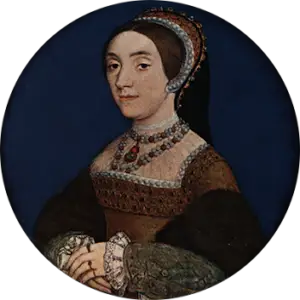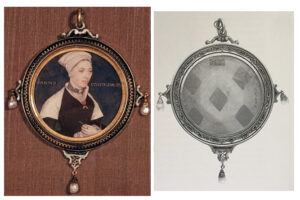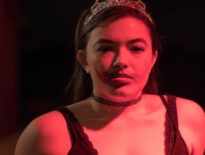A big thank you to our resident art historian, Roland Hui, for this excellent article on a Tudor miniature by Hans Holbein the Younger which is causing controversy at the moment.
Over to Roland...
In an essay on the portraiture of Henry VIII's six wives, art historian Brett Dolman offered the depressing, but sobering, opinion that pictures of one of them, Catherine Howard, may not even exist:
Catherine left no documentary proof that her portrait was ever painted during her lifetime, and perhaps, we are searching for the impossible.1
Nonetheless, a portrait miniature of an unknown lady by Hans Holbein continues to be associated with Catherine Howard, and it has recently been brought back to public attention by the claim that it was not of Henry VIII's fifth wife, but of his fourth, Anne of Cleves.
The miniature exists in two versions, one in the Royal Collection and the other, a repetition, in the Buccleuch Collection. The antiquarian George Vertue saw the latter in about 1736, and he noted that it was called 'Catherine Howard' by its then owner Jonathan Richardson. The other finer version was not officially known as her until the 1840s. It is unclear if this appellation was simply based on the Buccleuch copy, or independently arrived at. It was formerly identified - though incorrectly - as Henry VIII's sister, Mary Tudor, when it was engraved in the 17th century.2
By the early 20th century, the miniatures were more or less established as being of Catherine Howard. On the basis of this identification, art historian Lionel Cust, linked them to a large panel of an unknown sitter of age 21 (or in her 21st year) calling this lady Catherine as well.3
In 1983, Sir Roy Strong, then the Director of The National Portrait Gallery, believed that the sitter in the miniatures was probably Catherine Howard, based on the fact that two copies were made indicating that the individual was a person of exceptional status, and that her jewelry appears to be the same as that seen in a portrait of Jane Seymour, Henry VIII's third queen. In agreement with Strong regarding the jewels, historian David Starkey opined that the sitter was undoubtedly Catherine.4
But this identification has come under scrutiny. In 1998, historian Susan E. James thought that the miniatures were in fact of Margaret Douglas, Henry VIII's niece. Her high rank and that the 'faces are strikingly alike' led to this supposition. But that the two looked similar was entirely subjective on James's part, and her theory has never generated much support.5
More recently, author Franny Moyle has proposed that the so-called Catherine was actually her predecessor Anne of Cleves.6 Moyle noted a supposed resemblance to portraits of Anne, and that Henry VIII's fourth wife abandoned her dowdy German clothes in favour of new styles (as shown in the miniatures) as queen. Anne certainly did wear what was in vogue at the English court, and this was noted by the chronicler Edward Hall who described her as 'apparelled after the English fashion, with a French hood'.7
However, the lady in the miniatures who is clearly a brunette, cannot be Anne as she was a blond. While Moyle was ready to accept Hall's observation of her costume, she left out his other comment that on her wedding day (which Hall surely attended to give such a vivid description of it), Anne had her 'hair hanging down, which was fair, yellow, and long'.8 Moyle, on the other hand to make Anne able to have brown hair, merely described her as with 'long fair hair loose'. Hall's unequivocal 'yellow' was noticeably ignored. As well, Moyle's dismissal of the chronicler as 'an unreliable witness' is puzzling, given that she used Hall as a source regarding Anne's clothing.
Furthermore, Moyle pointed out that since Holbein used a '4 of Diamonds' playing card as the back support of the Royal Collection version of the miniature, it must surely have been a secret reference to Anne as Henry VIII's fourth wife.9 But then how to explain the significance of a '5 of Diamonds' card on the back of Holbein's picture of Jane Small?
All in all, Holbein's sitter remains a mystery. Until further evidence appears, she remains most likely Queen Catherine Howard. As two versions exist and the sumptuousness of her clothes and jewels suggest a very important personage, Henry VIII's tragic fifth wife remains a strong candidate.
Roland Hui received his degree in Art History from Concordia University in Canada. After completing his studies, he went on to work in Interpretive Media for California State Parks, The U.S. Forest Service, and The National Park Service. Roland has written for Renaissance Magazine and for Tudor Life Magazine. He blogs about 16th-century English art and personalities at Tudor Faces at: tudorfaces.blogspot.com. Roland is also the author of The Turbulent Crown: The Story of the Tudor Queens (2017) and The Mary, Queen of Scots Colouring Book, which is illustrated by Dmitry Yakhovsky (2019).
Notes
- Brett Dolman, 'Wishful Thinking: Reading the Portraits of Henry VIII's Queens', Henry VIII and the Court: Art, Politics and Performance (edited by Thomas Betteridge and Suzanna Liscombe, Burlington: Ashgate, 2013, p. 126.
- Roy Strong, Artists of the Tudor Court, London: The Victoria and Albert Museum, 1983, p. 50.
- Three versions of this picture exist: the original in the Toledo Museum of Art in Ohio, and copies at Hever Castle in Kent and in The National Portrait Gallery in London. The identity of the sitter, however, remains controversial.
- Strong, Artists of the Tudor Court, p. 50. David Starkey, Six Wives – The Queens of Henry VIII, London: Chatto & Windus, 2003, p. 651. See also: Bendor Grosvenor (editor), Lost Faces: Identity and Discovery in Tudor Royal Portraiture, London: Philip Mould, pp. 70-75.
- Susan E. James, 'Lady Margaret Douglas and Sir Thomas Seymour by Holbein: Two miniatures re-identified', Apollo, vol. 147, no. 425, 1998.
- Franny Moyle, The King's Painter: The Life and Times of Hans Holbein, London: Head of Zeus, 2021, pp. 525-531/621 on Kindle e-book.
- Edward Hall, Hall’s Chronicle; Containing the History of England, During the Reign of Henry the Fourth and the Succeeding Monarchs, London: printed for J. Johnson, 1809, p. 837.
- Ibid., p. 836.
- 'How Holbein left clever clue in portrait to identify Henry VIII’s queen', The Guardian, (by Dalya Alberge), May 1, 2021: https://www.theguardian.com/education/2021/may/01/how-holbein-left-clever-clue-in-portrait-to-identify-henry-viiis-queen (accessed Aug. 13, 2021).








Wow, very interesting article, thank you! I’m so fascinated by this mystery and wish there was some way to be absolutely certain. (Your recent podcast with Natalie Grueninger was awesome and so interesting.) Michelle t
Thanks Michelle for the kind words!: )
Yes, what an intriguing topic! It would certainly be unfortunate if the portrait is never proven for sure (or not) to be Catherine.. Thanks for the information!
Hello Laurie, thanks for reading!
If only Hans Holbein had labeled his portraits back then… : (
A very clear exposition of what is a very muddy dispute. Thank you Rolsnd for clarifying the issue.
Hello Clare,
Thank your for your interest in the article!